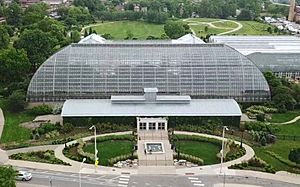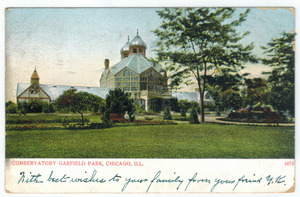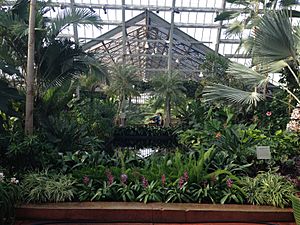Garfield Park Conservatory facts for kids
 |
|
| Established | 1880s, present structure 1908 |
|---|---|
| Location | 300 N. Central Park Avenue Chicago, Illinois, United States 60624 |
| Public transit access | |
The Garfield Park Conservatory is a huge indoor garden in Garfield Park, Chicago. It's one of the biggest greenhouse gardens in the United States. People often call it "landscape art under glass" because it's like a beautiful outdoor scene, but inside!
The conservatory covers about 4.5 acres (18,211 square meters) both inside and outside. It has many different plant displays with plants from all over the world. Some of its cycad plants are even more than 200 years old!
The Garfield Park Conservatory, along with the Lincoln Park Conservatory in Chicago, offers amazing plant collections. They also have fun educational programs and activities for the community.
Contents
History of the Conservatory
In the late 1800s, there were three smaller plant houses in Chicago's West Side parks. After about 20 years, these buildings were old and needed many repairs.
In 1905, a famous landscape architect named Jens Jensen had an idea. He was in charge of Chicago's West Park Commission. Jensen decided to tear down the three old greenhouses. He wanted to build one very large conservatory in Garfield Park. His goal was to create "the largest publicly owned conservatory under one roof in the world." Many of the first plants for the new conservatory came from those three smaller buildings.
The Garfield Park Conservatory was built between 1906 and 1907. Jens Jensen worked with architects and engineers to design it. It was a special project where many talented people worked together.
Jensen imagined the conservatory as natural outdoor scenes, but under glass. This was a very new idea at the time. The building's simple shape looks like haystacks from the Midwest. This design helps show off the amazing plants inside.
Inside the Conservatory
Today, the conservatory still follows Jensen's original ideas. One of the most popular areas is the Palm Room. It has more than 70 different kinds of palm trees! There are over 2,700 types of palm trees known in the world.
A very special plant was the double coconut palm. Conservatory workers first grew it in 1959. This rare palm tree is only found off the coast of South Africa in nature. It produces what is thought to be the biggest seed of any plant in the world. This seed can weigh up to 50 pounds (22.7 kilograms)! Sadly, the double coconut palm at the conservatory died in February 2012. Because it's so rare, it has not been replaced.
After many years, the conservatory needed a lot of work. In 1994, it had a huge restoration project that cost millions of dollars. A group called the Garfield Park Conservatory Alliance was formed. This group helps take care of the building and offers programs for visitors.
Storm Damage and Repairs
On June 30, 2011, a big hailstorm hit the conservatory. Many glass panels in the plant display rooms and growing areas were badly damaged. Luckily, five rooms had special laminated glass, so they were not as damaged. Some parts of the conservatory reopened to the public just a few days later. The Fern Room opened again on December 1, 2011. All other areas were open by January 24, 2012. To help pay for repairs, a local artist made special bowls from the broken glass. The conservatory sold these bowls to raise money.
The Garfield Park Conservatory is also a place where people have sometimes left their pets, like lizards and other reptiles. The staff tries to rescue these animals. Sometimes they are able to catch them and connect them with animal rescue groups. However, often these animals do not survive.
Awards and Honors
In 2012, the conservatory won the National Medal for Museum and Library Services. This is a very important award! In 2018, the Garfield Park Conservatory was chosen as one of the Illinois 200 Great Places. This honor was given by the American Institute of Architects Illinois.
Images for kids
-
Conservation work of an endangered coco de mer seed.
See also
 In Spanish: Garfield Park Conservatory para niños
In Spanish: Garfield Park Conservatory para niños












